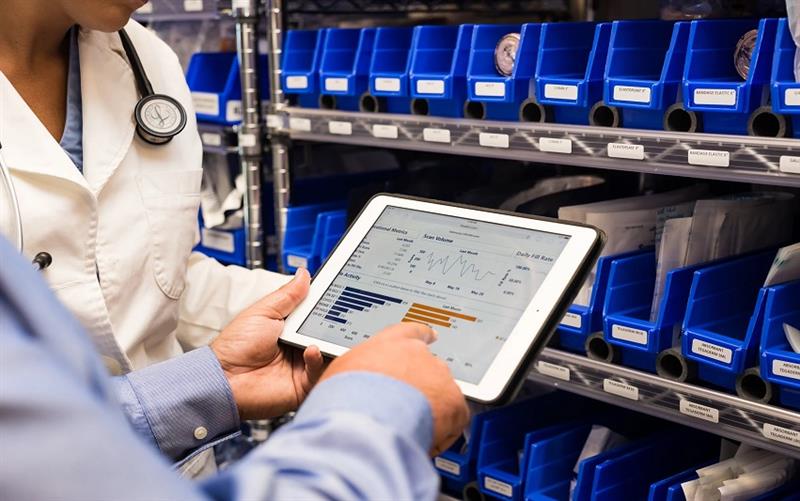
While minimizing expenses, efficient hospital inventory management guarantees continuous patient care. Predictive analytics, technology, and astute procurement techniques can help hospitals avoid shortages and overstock. By using these best practices, healthcare outcomes are improved, waste is decreased, and efficiency is increased.
Hospital inventory management requires careful balancing. While shortages can be fatal, excess inventory results in waste and higher expenses. Maintaining patient care and effective hospital operations require finding the ideal balance. In order to avoid shortages and overstock in hospitals, we examine intelligent inventory management techniques in this blog.
The Challenges of Hospital Inventory Management
Everyday consumables and life-saving equipment are among the thousands of medical supplies that hospitals handle. Among the major obstacles are:
Unpredictable demand: Seasonal fluctuations and emergencies may cause unexpected increases in demand.
Obsolescence and expiration: As technology advances, medical supplies may become outdated due to their limited shelf lives.
Storage restrictions: Limited space necessitates effective stock management and storage optimization.
Regulatory compliance: Strict guidelines pertaining to the storage and disposal of outdated commodities must be followed by hospitals.
Budgetary restrictions: Due to a lack of funds, inventory expenditures must be optimized without sacrificing patient care.
Disruptions to the supply chain: The availability of necessary medical supplies may be impacted by international events, delays in transit, and supplier shortages.
Smart Inventory Strategies for Hospitals
Effective hospital inventory management is essential for delivering seamless patient care, reducing waste, and optimizing operational costs. By leveraging technology, predictive analytics, and strategic procurement methods, hospitals can prevent both shortages and overstock, ensuring that critical medical supplies are always available when needed.
A well-executed inventory management system not only improves efficiency but also enhances patient safety, minimizes financial losses, and streamlines hospital workflows. Continuous monitoring, strong supplier relationships, and staff training are key to maintaining an optimized inventory system that adapts to changing healthcare demands.
1. Implement Real-Time Inventory Tracking
Automated inventory management systems using RFID and barcode scanning are used in modern hospitals. With the use of these real-time tracking tools, employees can:
Accurately track stock levels
Minimize human mistake in inventory documentation
Set up automated warnings to avoid shortages.
Determine which merchandise is outdated or slow-moving.
2. Adopt a Just-in-Time (JIT) Approach
By guaranteeing that goods arrive just when needed, the Just-In-Time (JIT) approach reduces unnecessary inventory. This method aids in:
Cut storage expenses and make room in the hospital
Reduce the amount of trash produced by out-of-date medical supplies
Strong supplier ties are necessary to avoid delays.
Put backup procedures in place for unforeseen surges in demand.
3. Classify Inventory Using the ABC Analysis
Hospital inventory can be divided into three categories:
A: Low-quantity, high-value goods (such as surgical instruments)
demand rigorous purchase planning and vigilant oversight.
B: Items of intermediate value and quantity (diagnostic tools, for example)
Stock levels must be balanced to prevent needless shortages or excesses.
C: High-quantity, low-value goods (such as syringes and gloves)
Buying in bulk could save money.
For increased efficiency, give each category a distinct management approach.
4. Use Demand Forecasting Techniques
Hospitals can anticipate demand by utilizing predictive analytics and historical data. This method makes it possible for:
Improved correspondence between purchase and use
More precise inventory spending budgeting
Preventing shortages and overstock
Using AI-powered technologies to improve forecasts of seasonal demand
5. Set Minimum and Maximum Stock Levels
Clear stock thresholds should be set by hospitals:
Minimum levels: To avoid shortages, initiate automatic reordering.
Maximum levels: Steer clear of surplus inventory that could result in waste.
To guarantee adherence to these levels, conduct routine audits.
Dashboards and automated alerts that offer real-time information on inventory status
6. Improve Supplier Relationships
Developing trusting connections with dependable providers guarantees:
Quicker delivery for pressing inventory requirements
Improved contract negotiations and price
Decreased possibility of stock shortages brought on by supplier delays
Plans for backup suppliers of necessary medical supplies
7. Integrate Inventory with Procurement Systems
Hospitals benefit from a smooth integration of procurement and inventory systems:
Purchase orders can be automatically generated based on current stock levels.
Monitor supplier performance to ensure on-time delivery.
Simplify replenishing procedures to prevent mistakes made by people.
Boost cost control and financial planning
8. Train Staff on Inventory Best Practices
Frequent training sessions guarantee that hospital employees:
Recognize how to handle and store medical goods properly.
Report shortfalls and effectively replenish supplies.
Keep abreast of emerging technology and best practices in inventory management.
Follow hospital inventory guidelines to ensure efficiency and compliance.
9. Utilize Automated Replenishment Systems
AI-powered automated replenishment systems can be used by hospitals to:
Forecast demand using historical usage patterns.
Lessen the workload for employees who must manually monitor stocks
Maintain ideal stock levels without placing excessive orders.
Enhanced ability to adapt to changes in demand
10. Optimize Storage and Distribution
Hospitals can benefit from effective distribution and storage systems:
Use RFID-enabled containers and flexible shelving to improve organization.
When storing delicate medical materials, use temperature-controlled storage.
Distribute supplies across several sites to decentralize inventory and increase accessibility.
By strategically positioning commonly used things, you can shorten the time it takes to retrieve them.